IJCRR - 12(18), September, 2020
Pages: 25-34
Date of Publication: 22-Sep-2020
Print Article
Download XML Download PDF
A Recent Report on 'Plants with Anti-Candida Properties'
Author: Darshan Kumar, Ayesha, Madhulika Jha, Pankaj Gautam, Himanshu Joshi, Navin Kumar
Category: Healthcare
Abstract:Fungal infections are drawing attention because of the high mortality and morbidity rate associated with them. Candida, Cryptococcus, Pneumocystis, and Aspergillus are the main members of fungal genera responsible for life-threatening fungal infections all over the world. Candida exists as commensal opportunistic pathogens in the natural flora of human beings. Members of this genus have specialized virulence attributes which include adhesion, biofilm formation, yeast to hyphal transition, cell surface hydrophobicity, and secretion of hydrolytic enzymes. C. albicans, C. parapsilosis, C. glabrata, and C. tropicalis are key species, mainly responsible for 95% of candidiasis worldwide. Azoles, amphotericin B, echinocandins and terbinafine are the main synthetic drugs against the pathogens. Rising resistance to antifungals demands the development of alternative drugs, especially of plant origin. In this review, we have included the selected plants having significant anti-Candida potential, based upon recent studies.
Keywords: Candida, Candidiasis, Biofilm, Anti-Candida, Phytoactive, Synthetic drugs, MIC, Camellia sinensis, Hypericum havvae.
Full Text:
INTRODUCTION
Fungi are considered to be one of the potential health hazards to animals including humans. Annually, fungal diseases are responsible for over 1.5 million deaths and infecting over a billion people worldwide. Candida, Cryptococcus, Pneumocystisand Aspergillus are the main fungal genera responsible for such infections1. The occurrence of life-threatening fungal infections has increased in immune-compromised AIDS patients, blood cancer, neonates, and organ transplants2,3. Fungal infections present a possible danger to health worldwide owing to their elevated mortality and morbidity rate 4. Mortality associated with the fungal disease is similar to that of tuberculosis (more than 1.6 million) and above 3-fold more than malaria 1.
Candida is a well-known group of fungi containing around 20 pathogenic species. It is a member of the Saccharomycetes class, the Saccharomycetales order, and the Saccharomycetaceae family. Ubiquitous, opportunistic, dimorphic, and commensal fungi are representatives of this group. The natural flora of the gastrointestinal tract, the mucosal oral cavity, and the human reproductive organs comprises of various species of Candida5.
Candidiasis is a condition of Candida infection which causes shallow mucocutaneous infections, invasive tissue, and bloodstream infections6,7. C. albicans, the most common pathogenic species, is followed by C. tropicalis, C. glabrata, and C. parapsilosis8. Clinical isolates have been reported to be resistant to existing antifungals, particularly azoles, echinocandins, and polyene9. Hydrophobicity of the cell surface, hyphal transformation hydrolytic enzyme secretion and development of biofilm over abiotic and biotic surfaces are well established primary virulence features of the Candida10,11. Most important features of Candida spp. are the ability to form a biofilm, a three-dimensional multicellular structure mainly composed of proteins, carbohydrates, phosphorus, hexosamine, and, uronic acid. Biofilm facilitates adhesion and maturation on the biotic and abiotic surfaces, ranging from the mineral surface and mammalian tissues to synthetic polymers and indwelling medical gadgets, resulting in drug resistance12,13,14.
For decades plants have been known as the primary source of medicinal products among common citizens. Additionally, several countries still used plants as major remedies, particularly in Africa and Asia. Several plants had exhibited successful anti-Candida activities which are required to be tested for efficacy and safety15.
GLOBAL BURDEN OF CANDIDIASIS
Candidiasis is due to the Candida albicans and non-albicans Candida (NAC) infection, which is mostly known to cause high rates of mucosal infection to humans worldwide.1 Candida infects mucosal tissues, including mouth, oesophagus, gastrointestinal, vagina, and deep tissue infection16. Vulvovaginal candidiasis (thrush or yeast infection) continues to be a worldwide health problem for women17,18. Candida infection is common in hospitalized patients having a weak immune system or immunocompromised patients and elderly people 19. More than 30 species of Candida have been recognized as the causative agent of candidiasis and approximately 95% of the contaminations are caused by its four species: C. albicans, C. parapsilosis, C. glabrata, and C. tropicalis20, 21.
Nearly 50% of individuals have Candida yeast in the oral cavity which is responsible for the superficial infection. However, Candida infection can spread through the body and can end-up in life-threatening incidences, specifically in immunocompromised patients 22, 23.
The global burden of candidiasis is given in Table-1.
(Table 1. Global burden of candidiasis)

DRUG RESISTANCE:
Azoles and its derivatives (fluconazole, voriconazole, Itraconazole, ketoconazole) are primarily used antifungals 24-25. Isolates of Candida have been reported to develop resistance to the existing antifungals (fluconazole, anidulafungin, caspofungin, micafungin, etc). According to the Centers for Disease Control and Prevention (CDC, NIH, USA), about 7% of all Candida bloodstream isolates tested at CDC were resistant to fluconazole and about 1.5% were resistant to Echinocandin (Figure 1).
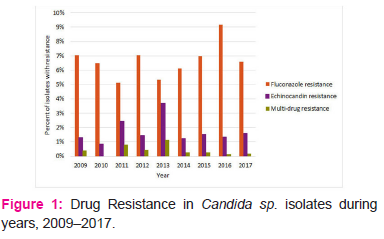
(Photo Source: CDC Report)
Increasing resistance to selected drugs encouraged the clinical practice of other drugs also e.g. amphotericin B, echinocandins, terbinafine, etc. as shown in Table-2 along with its mode of action.
(Table 2. Synthetic anti-Candida drugs)
PLANTS WITH ANTI-CANDIDA PROPERTIES:
Plants and their extracts have been used in traditional medicine since prehistoric times due to its availability and efficacy without toxicity33. Plants produce numbers of natural active compounds for defence against fungi, insects, and herbivorous mammals. And many more phytoactive compounds have biological activities34. The use of herbal medicines has been widely accepted in many developed and developing countries. Herbal remedies are widely used in Asia, mainly India and China, and are now getting popularity in the UK and Europe, as well as in North America and Australia33,35. WHO estimated that around 80% population of the developing countries (like Latin America, Asia, Africa, etc.) depends on traditional therapy based on herbal medicines for their primary health care needs. In the year 2000, the global trade of medicinal plants and their products was reported to be US$ 60 billion, with a projected forecast to touch US$ 5 trillion by 205035. India and China are the top global exporters of herbal drugs due to its systematic traditional knowledge of plant-based medicines and culture.

In the modern era, natural products are the source of bioactive substances with possible medical uses in pharmacy and dentistry. Natural ingredients include essential oils and their elements and can form part of several classes of compounds, most commonly phenylpropenes and terpenes with antioxidant, anti-inflammatory, antiseptic, and curative properties 36. Looking at the rising demand for plant-based drugs, we tried to compile the details of plants showing anti-Candida properties (Table-3).
(Table. 3: Plants having anti-Candida properties)
Table-3 is an effort to compile some recent studies in the subject matter in a tabulated form.
Biofilm is an important pathogenic implication of the Candida to survive the existing synthetic drug, which is responsible for drug resistance. Some of the plant extracts and their phytoactive compounds have exhibited remarkable anti-biofilm properties; e.g. Berberis vulgaris,42 Buchenaviatomentosa Eichler,44 Cinnamomum zeylanicum,47 Curcuma longa L.,48,49 Matricaria chamomilla,55 Peganum harmala L.58 and Sanguinaria Canadensis 61. Berberine, Sanguinarine, Harmaline, Curcumin, and many other phytoactive compounds have been reported to decrease the viability of Candida biofilm significantly42,48,49,61.
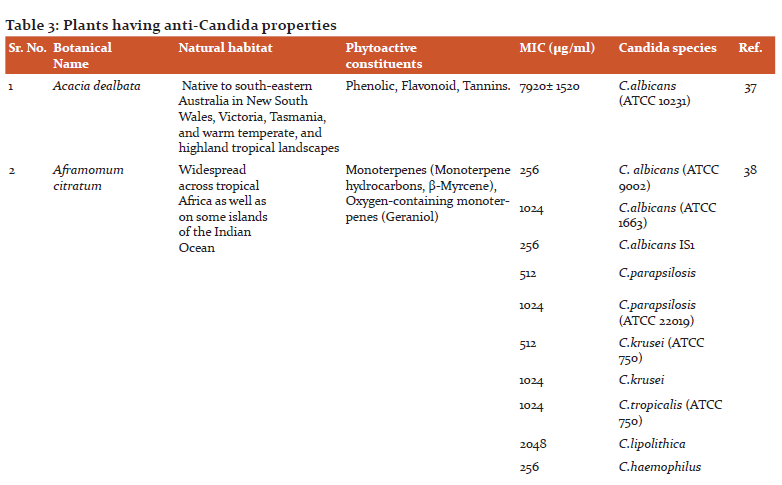
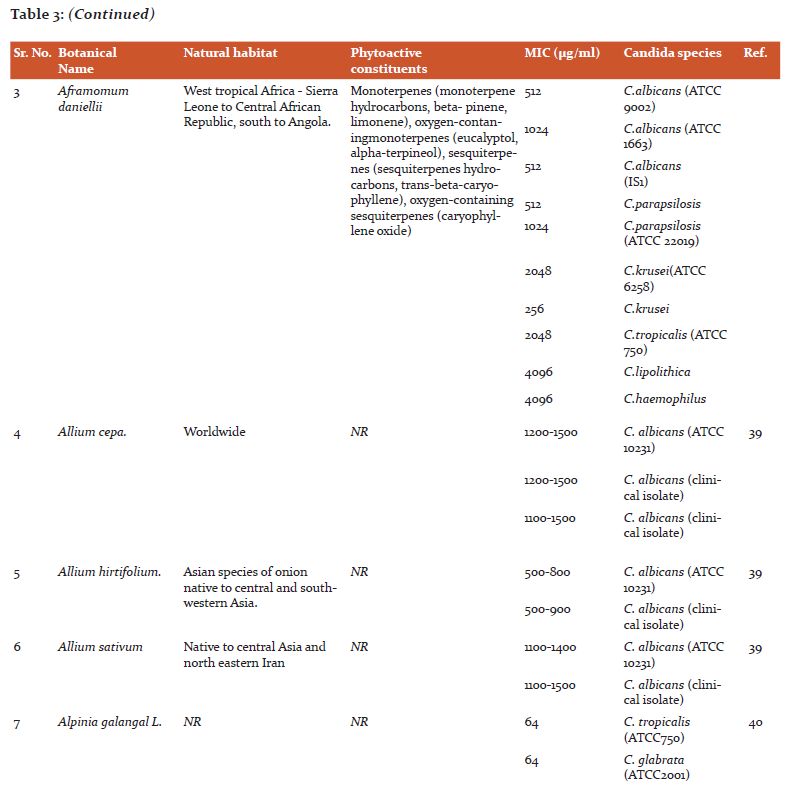

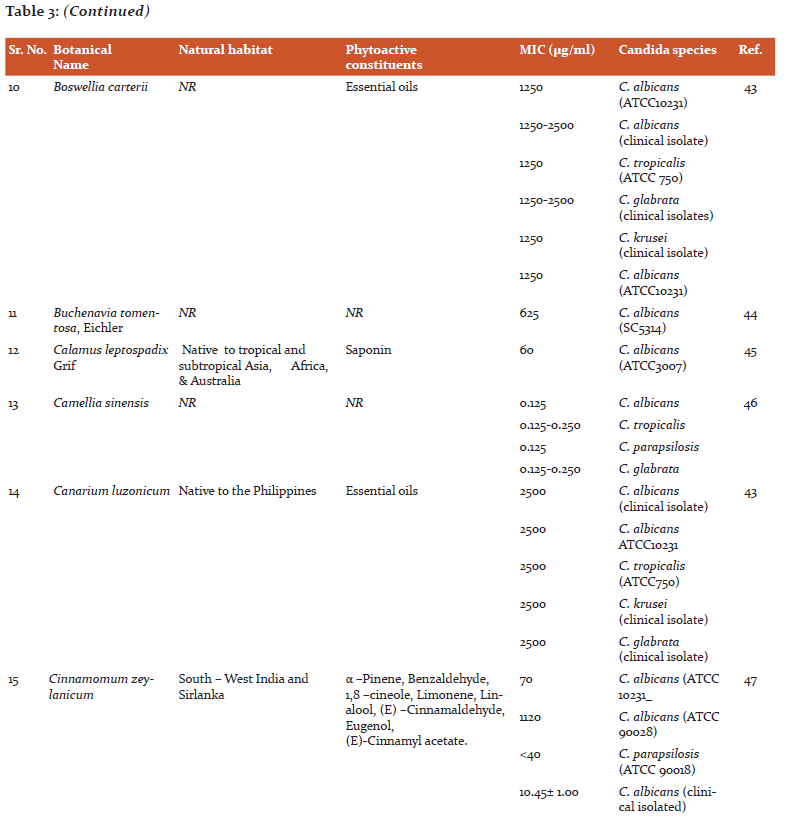

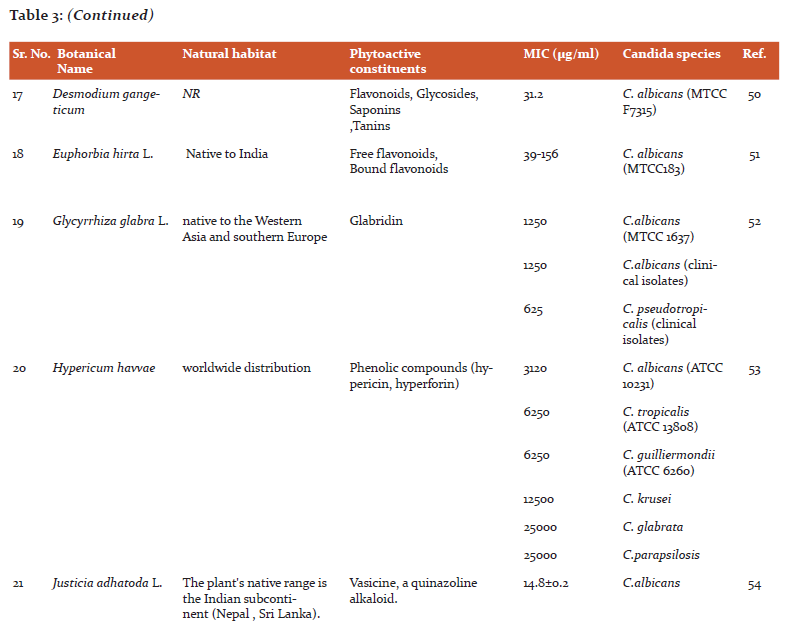
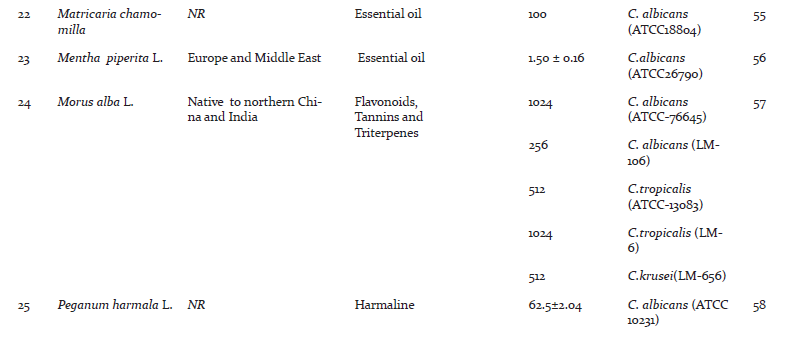
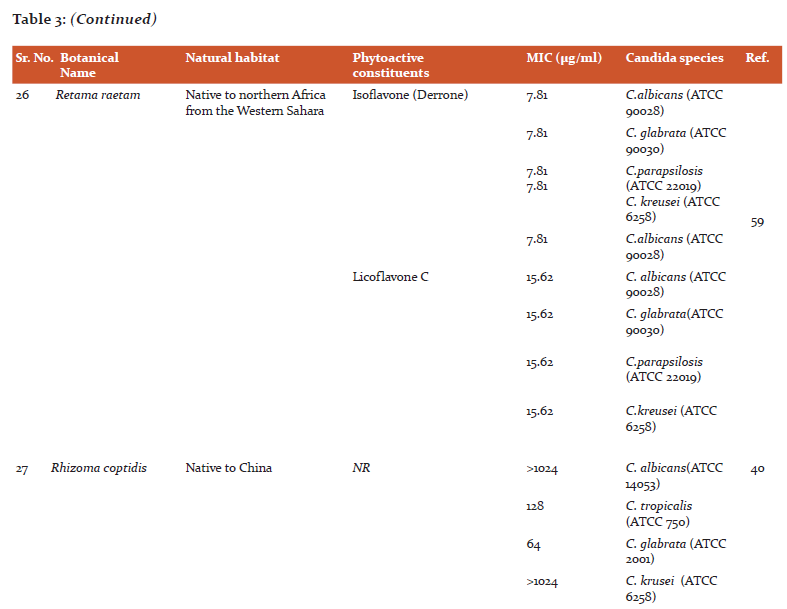
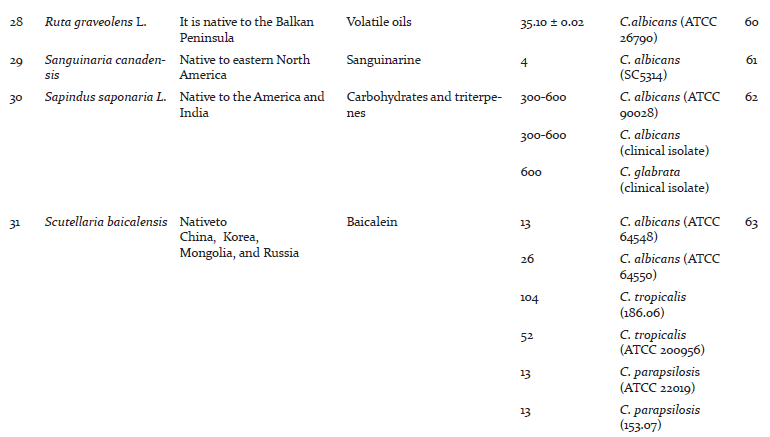
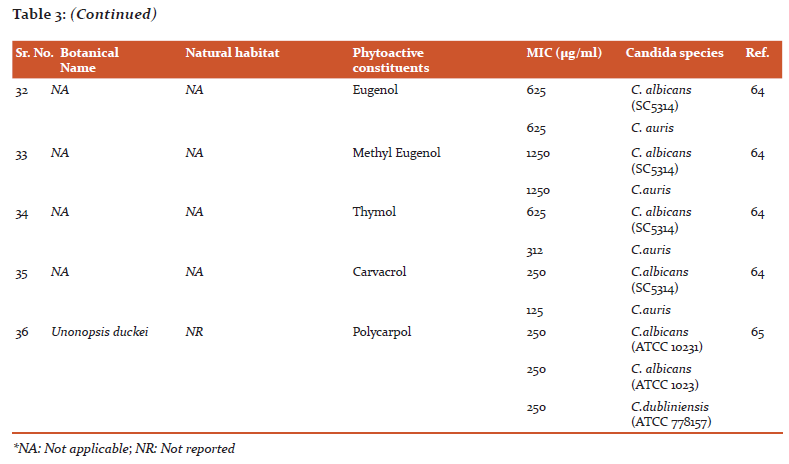
CONCLUSION
Since the prehistoric period, plants have been the source of medicine in different countries like India and China. According to a WHO report, approximately 80% of the premier health issues in developing countries depend on traditional medicine. Currently, the scientific research community and government health agencies are focusing on the studies related to the bioactive compounds. Phytoactive compounds are generally safe and easily available for commercial-scale drug production. Therefore, it’s encouraging to develop an effective and safe drug against microbial human pathogens from natural resources. Nature holds ample resources for the discovery of new and highly effective herbal drugs. It may be concluded from the table-3 that two plants Camellia sinensis and Hypericum havvae have remarkable anti-Candida properties and can be used to develop alternative anti-Candida drugs. Camellia sinensis have shown promising results against many pathogenic species of the Candida e.g. C. albicans, C. parapsilosis, C. Tropicalis, and C. Glabrata, and Hypericum havvae was effective against C. glabrata, C. kreusei, C. parapsilosis, C. guilliermondii, and C. tropicalis.
Source(s) of Funding: No funding is involved.
Conflicting Interest: The authors declare no conflicting interest.
References:
-
Bongomin F, Gago S, Oladele R, Denning D. Global and Multi-National Prevalence of Fungal Diseases—Estimate Precision. Journal of Fungi 2017;3(4):1-29.
-
Arendrup M. Epidemiology of invasive candidiasis. Current Opinion in Critical Care 2010; 16(5):445-452.
-
Espinel-Ingroff A, Canton E, Peman J, Rinaldi M, Fothergill A. Comparison of 24-Hour and 48-Hours Voriconazole MICs as Determined by the Clinical and Laboratory Standards Institute Broth Microdilution Method (M27-A3 Document) in Three Laboratories: Results Obtained with 2,162 Clinical Isolates of Candida spp. and Other Yeasts. Journal of Clinical Microbiology 2009; 47(9):2766-2771.
-
Liu W, Tan J, Sun J, Xu Z, Li M, Yang Q et al. Invasive candidiasis in intensive care units in China: in vitro antifungal susceptibility in the China-SCAN study. Journal of Antimicrobial Chemotherapy 2013; 69(1):162-167.
-
Shao LC, Sheng CQ, Zhang WN. Recent advances in the study of antifungal lead compounds with new chemical scaffolds. Yao XueXue Bao 2007; 42:1129–1136.
-
Eggimann P, Garbino J, Pittet D. Epidemiology of Candida species infections in critically ill non-immunosuppressed patients. The Lancet Infectious Diseases 2003;3(11):685-702.
-
Giri S, Kindo AJ. A review of Candida species causing bloodstream infection. Indian J.Med. Microbiol 2012; 30(3):270-278.
-
Sardi JCO, Scorzoni L, Bernardi T, Fusco-Almeida AM, Gianni MJS. Candida species: current epidemiology, pathogenicity, biofilm formation, natural antifungal products and new therapeutic options. J. Med. Microbiol 2013; 62:10-24.
-
Vale-Silva L, Sanglard D. Tipping the balance both ways: drug resistance and virulence in Candida glabrata. FEMS Yeast Research 2015; 15(4).
-
Yang YL. Virulence factors of Candida species. J Microbiol Immunol Infect 2003 Dec; 36(4):223-8.
-
Rodrigues M, Nakayasu E, Almeida I, Nimrichter L. The impact of proteomics on the understanding of functions and biogenesis of fungal extracellular vesicles. Journal of Proteomics 2014; 97:177-186.
-
Garci?a-Sa?nchez S, Aubert S, Iraqui I, Janbon G, Ghigo J, d'Enfert C. Candida albicans Biofilms: A Developmental State Associated with Specific and Stable Gene Expression Patterns. Eukaryotic Cell 2004;3(2):536-545.
-
Tournu H, Van Dijck P. Candida Biofilms and the Host: Models and New Concepts for Eradication. International Journal of Microbiology 2012; 2012:1-16.
-
Mathé L, Van Dijck P. Recent insights into Candida albicans biofilm resistance mechanisms. Current Genetics 2013;59(4):251-264.
-
Soliman S, Alnajdy D, El-Keblawy A, Mosa K, Khoder G, Noreddin A. Plants' natural products as alternative promising anti-Candida drugs. Pharmacognosy Reviews 2017;11(22):104-122.
-
Pellon A, Sadeghi Nasab S, Moyes D. New Insights in Candida albicans Innate Immunity at the Mucosa: Toxins, Epithelium, Metabolism, and Beyond. Frontiers in Cellular and Infection Microbiology 2020; 10:1-14.
-
Denning D, Kneale M, Sobel J, Rautemaa-Richardson R. Global burden of recurrent vulvovaginal candidiasis: a systematic review. Lancet Infect Dis 2018; 1-9.
-
Gandhi T, Patel M, Jain M. Antifungal Susceptibility of Candida against Six Antifungal Drugs by Disk Diffusion Method Isolated from Vulvovaginal Candidiasis. Int J Cur Res Rev 2015;7(11):1-6.
-
Sydnor ER, Perl TM. Hospital epidemiology and infection control in acute?care settings. Clin Microbiol Rev 2011; 24:141?73.
-
Turner S, Butler G. The Candida Pathogenic Species Complex. Cold Spring Harbor Perspectives in Medicine 2014; 4(9):19778-19778.
-
Gabaldón T, Carreté L. The birth of a deadly yeast: tracing the evolutionary emergence of virulence traits in Candida glabrata. FEMS Yeast Research 2015;16(2): fov110.
-
Elewski B. Onychomycosis: Pathogenesis, Diagnosis, and Management. Clinical Microbiology Reviews 1998;11(3):415-429.
-
Tada H, Nemoto E, Shimauchi H, Watanabe T, Mikami T, Matsumoto T et al. Saccharomyces cerevisiae and Candida albicans-Derived Mannan Induced Production of Tumor Necrosis Factor Alpha by Human Monocytes in a CD14- and Toll-Like Receptor 4-Dependent Manner. Microbiology and Immunology. 2002; 46(7):503-512.
-
Pandya I, Shinojia M, Vadukul D, Marfatia Y. Approach to balanitis/balanoposthitis: Current guidelines. Indian Journal of Sexually Transmitted Diseases and AIDS 2014;35(2):155.
-
Maertens J. History of the development of azole derivatives. Clinical Microbiology and Infection 2004; 10:1-10.
-
Mesa-Arango A, Rueda C, Román E, Quintin J, Terrón M, Luque D et al. Cell Wall Changes in Amphotericin B-Resistant Strains from Candida tropicalis and Relationship with the Immune Responses Elicited by the Host. Antimicrobial Agents and Chemotherapy 2016;60(4):2326-2335.
-
Sanglard D, Ischer F, Parkinson T, Falconer D, Bille J. Candida albicans Mutations in the Ergosterol Biosynthetic Pathway and Resistance to Several Antifungal Agents. Antimicrobial Agents and Chemotherapy 2003;47(8):2404-2412.
-
Perea S, Patterson T. Antifungal Resistance in Pathogenic Fungi. Clinical Infectious Diseases 2002; 35(9):1073-1080.
-
Pfaller M, Jones R, Doern G, Sader H, Messer S, Houston A et al. Bloodstream Infections Due to Candida Species: SENTRY Antimicrobial Surveillance Program in North America and Latin America, 1997-1998. Antimicrobial Agents and Chemotherapy 2000; 44(3):747-751.
-
Pristov K, Ghannoum M. Resistance of Candida to azoles and echinocandins worldwide. Clinical Microbiology and Infection 2019; 25(7):792-798.
-
RYDER N. Terbinafine: Mode of action and properties of the squalene epoxidase inhibition. British Journal of Dermatology 1992;126(s39):2-7.
-
Hemelin S, ElzaL, SegatoF, Rossi A and Martinez-Rossi N. Terbinafine resistance conferred by multiple copies of the salicylate 1-monooxygenase gene in Trichophyton rubrum. Medical Mycology 2018;1;56(3):378-381
-
Ekor M. The growing use of herbal medicines: issues relating to adverse reactions and challenges in monitoring safety. Frontiers in Pharmacology 2014;4(177):1-10.
-
Shuping D, Eloff J. The use of plants to protect plants and food against fungal pathogens: a review. African Journal of Traditional, Complementary and Alternative medicines 2017;14(4):120-127.
-
Nirmal SA, Pal SC, Otimenyin SO, Aye T, Elachouri M, Kundu SK, et al. Contribution of Herbal Products In Global Market 2013. The Pharma Review. 2013; November - December 2013: 95-104.
-
Dhifi W, Bellili S, Jazi S, Bahloul N, Mnif W. Essential Oils’ Chemical Characterization and Investigation of Some Biological Activities: A Critical Review. Medicines 2016;3(4):25.
-
Yildiz S, Gürgen A, Can Z, Tabbouche S, Kiliç A. Some bioactive properties of Acacia dealbata extracts and their potential utilization in wood protection. Drewno 2018; 61 (202):1-17.
-
Sylvie C, Jean-De-Dieu T, Guy S, Pierre T, Jules-Roger K. Chemical composition and antimicrobial activity of essential oils from Aframomum citratum, Aframomum daniellii, Piper capense and Monodora myristica. Journal of Medicinal Plants Research 2019; 13(9):173-187.
-
Sadri A, Khodavandi A, Alizadeh F. Quorum-Sensing Quenching Compounds Allium sativum, Allium hirtifolium and Allium cepa: The Probable Quorum- Sensing Quenching Compounds against Candida albicans. Biosciences, Biotechnology Research Asia 2016;13(3):1457-1468.
-
Khodavandi A, Tahzir N, Cheng P, Chen P, Alizadeh F, Hrmal N et al. Antifungal Activity of Rhizome coptidis and Alpinia galangal against Candida species. J. Pure Appl. Micro. 2003; 7(3):1725-1730.
-
Tahzir J, Khodavandi D, Alizadeh M. In vitro study on the anti-microbial efficacy of Aloe vera against Candida albicans. African Journal of Microbiology Research 2018;12(40):930-937.
-
Xie Y, Liu X, Zhou P. In vitro Antifungal Effects of Berberine Against Candida spp. In Planktonic and Biofilm Conditions. Drug Design, Development and Therapy 2020;14: 87–101.
-
Nikoli?a M, Smiljkovi?aM, Markovi?b T, ?iri?a A , Glamo?lijaa J, Markovi?c D, Sokovi?a M. Sensitivity of clinical isolates of Candida to essential oils from Burseraceae family. EXCLI J. (Experimental and Clinical Sciences) 2016; 15: 280–289.
-
Teodoro G, Gontijo A, Salvador M, Tanaka M, Brighenti F, Delbem A et al. Effects of Acetone Fraction From Buchenaviatom entosa Aqueous Extract and Gallic Acid on Candida albicans Biofilms and Virulence Factors. Frontiers in Microbiology 2018;9(647):1-10.
-
Borah B, Phukon P, Hazarika M, Ahmed R, Sarmah D, Wann S et al. Calamus leptospadix Griff. a high saponin yielding plant with antimicrobial property. Industrial Crops and Products 2016; 82:127-132.
-
Hanci H, Co?kun M, Uyanik M, Sezen S, Igan H. In vitro Antifungal Activities of Fluconazole, Camellia sinensis and Cydonia oblonga leaf extracts against Candida species isolated from blood cultures. Bezmialem Science 2019;7(2):107-112.
-
Unlu M, Ergene E, Unlu G, Zeytinoglu H, Vural N. Composition, antimicrobial activity and in vitro cytotoxicity of essential oil from Cinnamomum zeylanicum Blume (Lauraceae). Food and Chemical Toxicology 2010; 48(11):3274-3280.
-
Neelofar K, Shreaz S, Rimple B, Muralidhar S, Nikhat M, Khan L. Curcumin as a promising anticandidal of clinical interest. Canadian Journal of Microbiology 2011;57(3):204-210.
-
Alalwan H, Rajendran R, Lappin D, Combet E, Shahzad M, Robertson D et al. The Anti-Adhesive Effect of Curcumin on Candida albicans Biofilms on Denture Materials. Frontiers in Microbiology 2017;8(659):1-9.
-
Lagudu M and Owk A. Antimicrobial activity and phytochemicals constituents of Desmodium gangeticum leaves 2016;1(3):44-52.
-
Singh G, Kumar P. Phytochemical study and screening for antimicrobial activity of flavonoids of Euphorbia hirta. International Journal of Applied and Basic Medical Research. 2013;3(2):1-7.
-
Fatima A, Gupta V, Luqman S, Negi A, Kumar J, Shanker K et al. Antifungal activity of Glycyrrhiza glabra extracts and its active constituent glabridin. Phytotherapy Research 2009;23(8):1190-1193.
-
Dulger G, Dulger B. Antifungal Activity of Hypericum havvae Against Some Medical Candida Yeast and Cryptococcus Species. Tropical Journal of Pharmaceutical Research March 2014; 13 (3): 405-408.
-
Pa R, Mathew L. Antimicrobial activity of leaf extracts of Justicia adhatoda L. in comparison with vasicine. Asian Pacific Journal of Tropical Biomedicine 2012;2(3): S1556-S1560.
-
Pequeno M, Silvestre M, Amêndola I, Silva C, Leão M, Santos S. Matricaria recutita Extract (Chamomile) to reduce Candida albicans and Enterobacter Cloacae biofilms: in vitro study. RGO, Rev Gauch Odontol, Porto Alegre 2018;66(2):122-128.
-
Desam N, Al-Rajab A, Sharma M, Mylabathula M, Gowkanapalli R, Albratty M. Chemical constituents, in vitro antibacterial and antifungal activity of Mentha piperita L. (peppermint) essential oils. Journal of King Saud University – Science 2019; 31(4):528-533.
-
de Oliveira A, Mesquita M, da Silva G, de Oliveira Lima E, de Medeiros P, Paiva P et al. Evaluation of Toxicity and Antimicrobial Activity of an Ethanolic Extract from Leaves of Morus alba L. (Moraceae). Evidence-Based Complementary and Alternative Medicine 2015;2015:1-7.
-
Iranshahy M, Bazzaz S F, Haririzadeh G, AbootorabiB Z, Mohamadi A M, Khashyarmanesh. Chemical composition and antibacterial properties of Peganum harmala L. Avicenna J Phytomed 2019; 9(6): 530-537.
-
Edziri H, Mastouri M, Mahjoub M, Mighri Z, Mahjoub A, Verschaeve L. Antibacterial, Antifungal and Cytotoxic Activities of Two Flavonoids from Retama raetam flowers. Molecules 2012; 17(6):7284-7293.
-
Reddy D, Al-Rajab A.Chemical composition, antibacterial and antifungal activities of Ruta graveolens L. volatile oils. Cogent Chemistry 2016; 2(1220055):1-11.
-
Zhong H, Hu D, Hu G, Su J, Bi S, Zhang Z et al. Activity of Sanguinarine against Candida albicans Biofilms. Antimicrobial Agents and Chemotherapy 2017;61(5):1-9.
-
Tsuzuki J, Svidzinski T, Shinobu C, Silva L, Rodrigues-Filho E, Cortez D et al. Antifungal activity of the extracts and saponins from Sapindus saponaria L. Anais da Academia Brasileira de Ciências 2007;79(4):577-583.
-
Serpa R, França E, Furlaneto-Maia L, Andrade C, Diniz A, Furlaneto M. In vitro antifungal activity of the flavonoid baicalein against Candida species. Journal of Medical Microbiology 2012;61(12):1704-1708.
-
Shaban S, Patel M, Ahmad A. Improved efficacy of antifungal drugs in combination with monoterpene phenols against Candida auris. Scientific Reports 2020; 10(1162):1-8.
-
Silva F, Lima B, Soares E, Almeida R, Silva Filho F, Corrêa W et al. Polycarpol in Unonopsis, Bocageopsis and Onychopetalum amazonian species: chemosystematical implications and antimicrobial evaluation. Revista Brasileira de Farmacognosia 2015; 25(2015):11–15.
|






 This work is licensed under a Creative Commons Attribution-NonCommercial 4.0 International License
This work is licensed under a Creative Commons Attribution-NonCommercial 4.0 International License